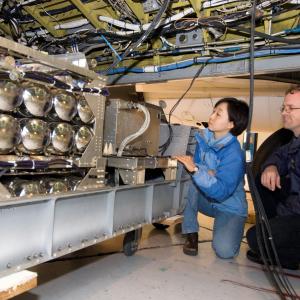Primary tabs
High-Sensitivity Fast-Response CO2 Analyzer (Harvard CO2)
The high-sensitivity fast response CO2 instrument measures CO2 concentrations in situ using the light source, gas cells, and solid-state detector from a modified nondispersive infrared CO2 analyzer (Li-Cor, Inc., Lincoln, NE). These components are stabilized along the detection axis, vibrationally isolated, and housed in a temperature-controlled pressure vessel. Sample air enters a rear-facing inlet, is preconditioned using a Nafion drier (to remove water vapor), then is compressed by a Teflon diaphragm pump. A second water trap, using dry ice, reduces the sample air dewpoint to less than 70C prior to detection. The CO2 mixing ratio of air flowing through the sample gas cell is determined by measuring absorption at 4.26 microns relative to a reference gas of known concentration. In-flight calibrations are performed by replacing the air sample with reference gas every 10 minutes, with a low-span and a high-span gas every 20 minutes, and with a long-term primary standard every 2 hours. The long-term standard is used sparingly and serves as a check of the flight-to-flight accuracy and precision of the measurements, augmented by ground-based calibrations before and after flights.
Instrument Type:
Measurements:
Aircraft:
Balloon, ER-2 - AFRC, WB-57 - JSC
Recent Missions:
ASHOE/MAESA (ER-2 - AFRC); STRAT (Balloon, ER-2 - AFRC); TC4 (WB-57 - JSC); CR-AVE (WB-57 - JSC); CRYSTAL FACE (WB-57 - JSC); SOLVE (ER-2 - AFRC, Balloon)
Complete mission list:
- ASHOE/MAESA (ER-2 - AFRC)
- STRAT (Balloon, ER-2 - AFRC)
- TC4 (WB-57 - JSC)
- CR-AVE (WB-57 - JSC)
- CRYSTAL FACE (WB-57 - JSC)
- SOLVE (ER-2 - AFRC, Balloon)
- POLARIS (ER-2 - AFRC)
- SPADE (ER-2 - AFRC)
- OMS (Balloon)
Point(s) of Contact:

